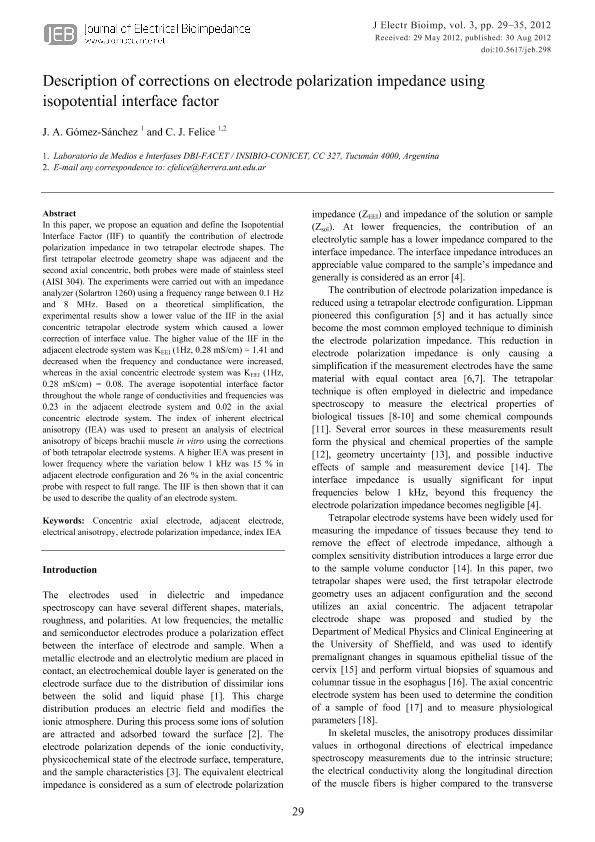Mostrar el registro sencillo del ítem
dc.contributor.author
Gomez Sanchez, John Alexander

dc.contributor.author
Felice, Carmelo Jose

dc.date.available
2018-10-01T20:16:21Z
dc.date.issued
2012-07
dc.identifier.citation
Gomez Sanchez, John Alexander; Felice, Carmelo Jose; Description of corrections on electrode polarization impedance using isopotential interface factor; Oslo Bioimpedance Group; Journal of Electrical Bioimpedance; 3; 1; 7-2012; 29-35
dc.identifier.issn
1891-5469
dc.identifier.uri
http://hdl.handle.net/11336/61452
dc.description.abstract
In this paper, we propose an equation and define the Isopotential Interface Factor (IIF) to quantify the contribution of electrode polarization impedance in two tetrapolar electrode shapes. The first tetrapolar electrode geometry shape was adjacent and the second axial concentric, both probes were made of stainless steel (AISI 304). The experiments were carried out with an impedance analyzer (Solartron 1260) using a frequency range between 0.1 Hz and 8 MHz. Based on a theoretical simplification, the experimental results show a lower value of the IIF in the axial concentric tetrapolar electrode system which caused a lower correction of interface value. The higher value of the IIF in the adjacent electrode system was KEEI (1Hz, 0.28 mS/cm) = 1.41 and decreased when the frequency and conductance were increased, whereas in the axial concentric electrode system was KEEI (1Hz, 0.28 mS/cm) = 0.08. The average isopotential interface factor throughout the whole range of conductivities and frequencies was 0.23 in the adjacent electrode system and 0.02 in the axial concentric electrode system. The index of inherent electrical anisotropy (IEA) was used to present an analysis of electrical anisotropy of biceps brachii muscle in vitro using the corrections of both tetrapolar electrode systems. A higher IEA was present in lower frequency where the variation below 1 kHz was 15 % in adjacent electrode configuration and 26 % in the axial concentric probe with respect to full range. The IIF is then shown that it can be used to describe the quality of an electrode system.
dc.format
application/pdf
dc.language.iso
eng
dc.publisher
Oslo Bioimpedance Group
dc.rights
info:eu-repo/semantics/openAccess
dc.rights.uri
https://creativecommons.org/licenses/by-nc-sa/2.5/ar/
dc.subject
Meat
dc.subject
Permitivitty
dc.subject
Impedance
dc.subject
Tenderness
dc.subject.classification
Otras Ciencias Veterinarias

dc.subject.classification
Ciencias Veterinarias

dc.subject.classification
CIENCIAS AGRÍCOLAS

dc.title
Description of corrections on electrode polarization impedance using isopotential interface factor
dc.type
info:eu-repo/semantics/article
dc.type
info:ar-repo/semantics/artículo
dc.type
info:eu-repo/semantics/publishedVersion
dc.date.updated
2018-10-01T15:22:27Z
dc.journal.volume
3
dc.journal.number
1
dc.journal.pagination
29-35
dc.journal.pais
Noruega

dc.journal.ciudad
Oslo
dc.description.fil
Fil: Gomez Sanchez, John Alexander. Consejo Nacional de Investigaciones Científicas y Técnicas. Centro Científico Tecnológico Conicet - Tucumán. Instituto Superior de Investigaciones Biológicas. Universidad Nacional de Tucumán. Instituto Superior de Investigaciones Biológicas; Argentina. Universidad Nacional de Tucumán. Facultad de Ciencias Exactas y Tecnología. Departamento de Bioingeniería. Laboratorio de Medios e Interfases; Argentina
dc.description.fil
Fil: Felice, Carmelo Jose. Consejo Nacional de Investigaciones Científicas y Técnicas. Centro Científico Tecnológico Conicet - Tucumán. Instituto Superior de Investigaciones Biológicas. Universidad Nacional de Tucumán. Instituto Superior de Investigaciones Biológicas; Argentina
dc.journal.title
Journal of Electrical Bioimpedance
dc.relation.alternativeid
info:eu-repo/semantics/altIdentifier/url/https://www.journals.uio.no/index.php/bioimpedance/article/download/298
dc.relation.alternativeid
info:eu-repo/semantics/altIdentifier/doi/https://dx.doi.org/10.5617/jeb.298
Archivos asociados
